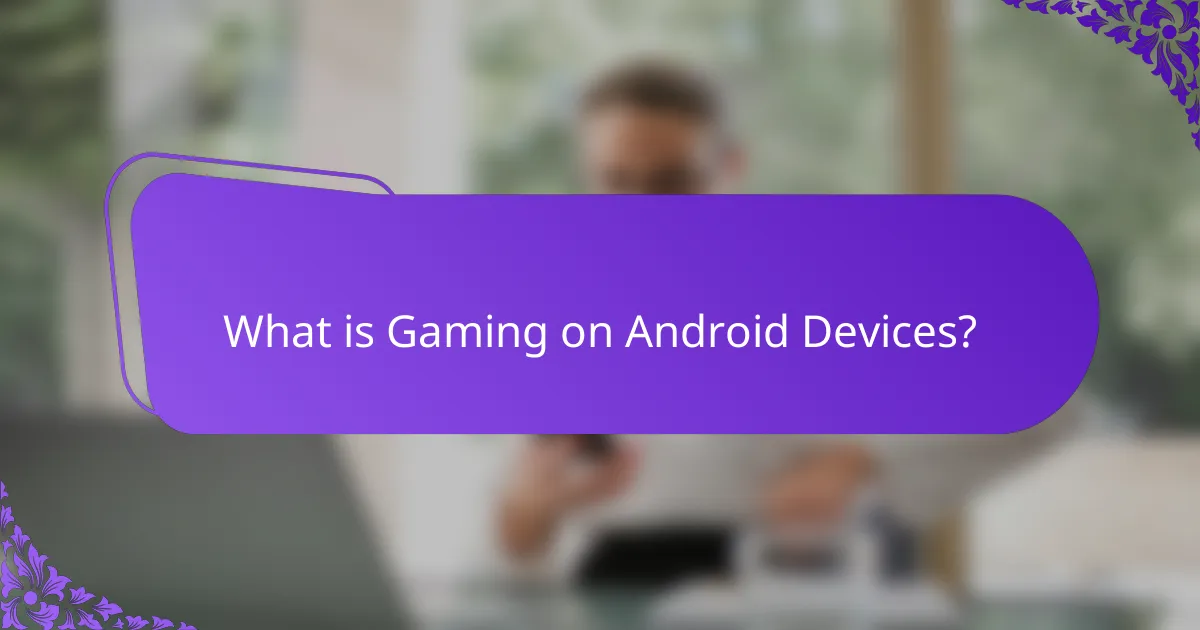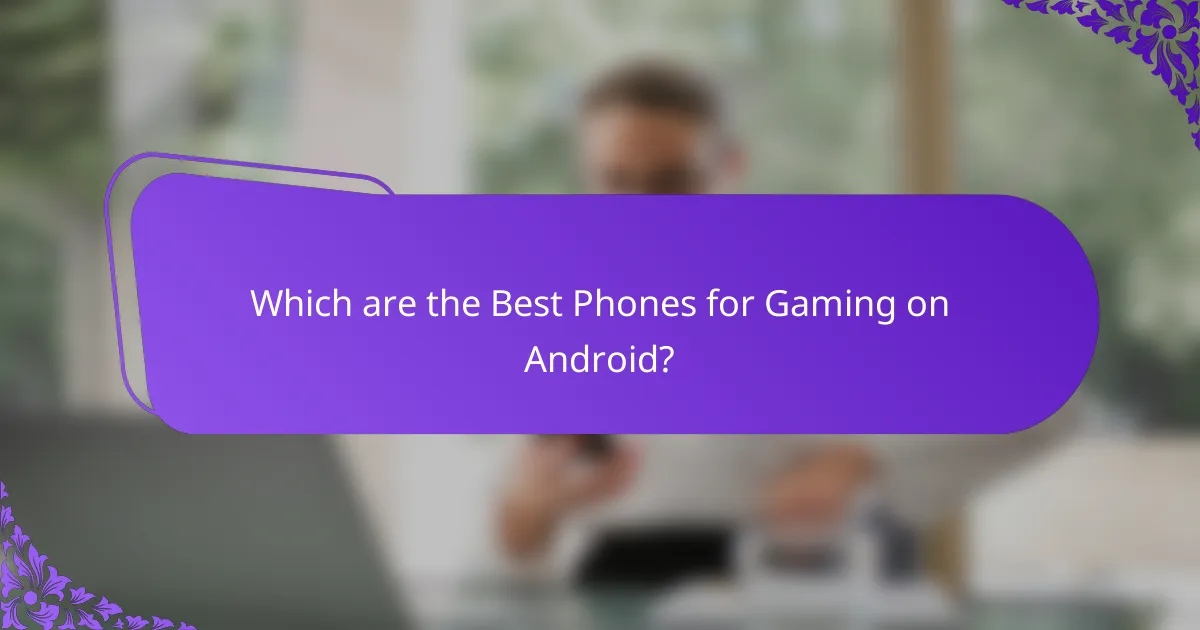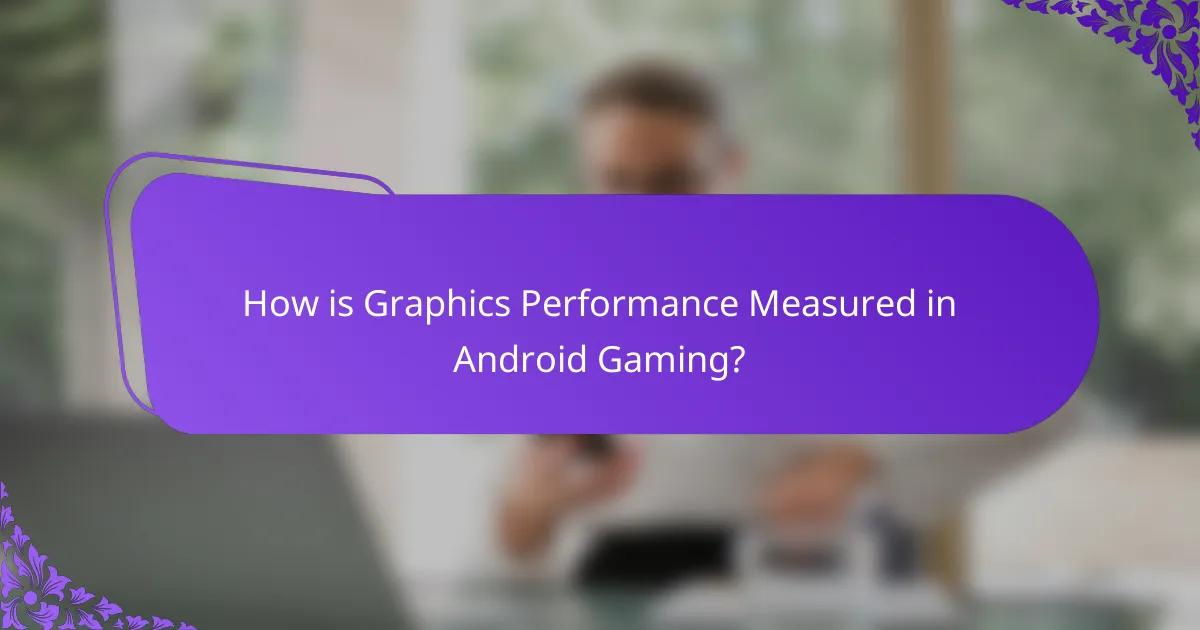Gaming on Android devices involves playing video games on smartphones and tablets that utilize the Android operating system, covering various genres such as action, strategy, puzzle, and role-playing games. This article explores the best Android phones for gaming, highlighting models like the ASUS ROG Phone 6, Samsung Galaxy S23 Ultra, and Xiaomi Black Shark 5 Pro, which are recognized for their superior performance and graphics capabilities. It also examines key metrics for assessing graphics performance, including frame rate, resolution, and graphical fidelity, as well as best practices for game optimization to enhance the gaming experience. With mobile gaming generating significant revenue, understanding these elements is crucial for both gamers and developers.

What is Gaming on Android Devices?
Gaming on Android devices refers to playing video games on smartphones and tablets powered by the Android operating system. Android gaming encompasses a wide range of genres, including action, strategy, puzzle, and role-playing games. These games can be downloaded from various platforms, such as the Google Play Store. Android devices support both casual and high-performance gaming experiences. Many Android devices feature advanced graphics capabilities, allowing for immersive gameplay. According to a report by Newzoo, mobile gaming generated over $77 billion in revenue in 2020, highlighting its popularity. Additionally, the Android ecosystem allows for regular updates and optimizations to enhance gaming performance.
How has gaming evolved on Android platforms?
Gaming on Android platforms has significantly evolved over the years. Initially, games were simple 2D applications with basic graphics. As technology advanced, 3D graphics became more common, enhancing visual appeal. The introduction of powerful processors and GPUs in Android devices improved game performance. Mobile gaming now supports high-definition graphics and complex gameplay mechanics. Additionally, the rise of online multiplayer gaming has transformed user interaction. The Google Play Store has expanded its library, offering diverse genres and titles. Cloud gaming services have further enriched the gaming experience by allowing access to high-quality games without heavy downloads. These advancements reflect a growing market, with mobile gaming revenue surpassing console and PC gaming in recent years.
What are the key milestones in Android gaming history?
The key milestones in Android gaming history include the launch of the first Android device in 2008. This device, the HTC Dream, introduced mobile gaming to the Android platform. In 2010, the introduction of the Android Market (now Google Play Store) allowed developers to distribute games widely. The release of Android 3.0 in 2011 brought support for high-performance gaming with enhanced graphics capabilities.
The launch of Google Play Games in 2013 enabled social features and cloud saving for Android games. In 2014, the introduction of Android Lollipop improved performance and graphics rendering. The arrival of Vulkan API in 2015 provided developers with low-level access to the GPU, enhancing gaming performance.
In 2018, the launch of Google Play Pass offered a subscription service for premium games. The introduction of 5G technology in 2019 further enhanced mobile gaming experiences with faster connectivity. These milestones highlight the evolution and growth of gaming on Android devices.
How do Android devices compare to other gaming platforms?
Android devices offer a diverse range of gaming options compared to other platforms. They support a wide variety of games, from casual to more demanding titles. Android’s accessibility allows millions of users to engage without the need for expensive hardware. In contrast, consoles and PCs often require significant investment in hardware and accessories.
Performance-wise, high-end Android devices can compete with mid-range gaming consoles. Some flagship models feature powerful processors and GPUs. This enables them to run graphically intensive games smoothly. However, dedicated gaming consoles typically provide superior graphics and performance due to optimized hardware.
Additionally, Android devices benefit from portability. Users can play games anywhere, unlike traditional consoles that are stationary. The Google Play Store offers a vast library of games, often with frequent updates. This contrasts with console stores, which may have more limited selections and longer release cycles for new titles.
In summary, Android devices provide accessibility and portability, while other platforms may excel in performance and graphics.
What are the essential features for gaming on Android devices?
Essential features for gaming on Android devices include a powerful processor, ample RAM, and a high refresh rate display. A powerful processor ensures smooth gameplay and fast loading times. Ample RAM, typically 6GB or more, allows for multitasking and running demanding games. A high refresh rate display, such as 90Hz or 120Hz, enhances visual fluidity. Additionally, good battery life is crucial for extended gaming sessions. Efficient cooling systems prevent overheating during intense gameplay. Robust graphics capabilities, often supported by GPUs like Adreno or Mali, improve visual quality. Finally, gaming-specific software optimizations, such as game modes, enhance performance and reduce distractions. These features collectively contribute to an optimal gaming experience on Android devices.
How does screen size influence gaming experience?
Screen size significantly influences the gaming experience by affecting visibility and immersion. Larger screens provide a wider field of view. This enhances the ability to spot details and navigate complex environments. Players often feel more engaged with larger displays. A study by the University of Utah found that larger screens improve reaction times in fast-paced games. Conversely, smaller screens can limit visibility and make gameplay feel cramped. The resolution also plays a role; higher resolutions on larger screens can lead to clearer images. Overall, screen size impacts both gameplay dynamics and user satisfaction.
What role does battery life play in mobile gaming?
Battery life is crucial in mobile gaming as it directly impacts gameplay duration. Extended gaming sessions require sufficient battery to avoid interruptions. Players often seek devices with high-capacity batteries, typically above 4000 mAh, for optimal performance. A device with poor battery life can lead to frustration and reduced gaming experience. Research indicates that games with high graphics settings consume more power, necessitating efficient battery management. Therefore, battery life influences not only the enjoyment of mobile gaming but also the choice of devices by gamers.

Which are the Best Phones for Gaming on Android?
The best phones for gaming on Android include the ASUS ROG Phone 6, Samsung Galaxy S23 Ultra, and Xiaomi Black Shark 5 Pro. The ASUS ROG Phone 6 features a Snapdragon 8+ Gen 1 processor and a 165Hz AMOLED display. This combination provides smooth graphics and fast response times. The Samsung Galaxy S23 Ultra offers a powerful Snapdragon 8 Gen 2 chip and a 120Hz display, ensuring high-quality gaming performance. The Xiaomi Black Shark 5 Pro is equipped with a Snapdragon 8 Gen 1 processor and a 144Hz display, enhancing the gaming experience. These models are widely recognized for their superior gaming capabilities and performance benchmarks.
What criteria should be considered when choosing a gaming phone?
When choosing a gaming phone, consider performance, display quality, battery life, and cooling system. Performance includes the processor and RAM, which should be high to run games smoothly. A high refresh rate display enhances gaming visuals, making gameplay more fluid. Battery life is crucial for extended gaming sessions, with a minimum of 4000 mAh recommended. An efficient cooling system prevents overheating during intensive gaming. Additional features like customizable controls and gaming modes can enhance the gaming experience.
How do processor and RAM specifications impact gaming performance?
Processor and RAM specifications significantly impact gaming performance. A powerful processor enables faster calculations and better handling of complex game mechanics. High clock speeds and multiple cores enhance multitasking and frame rates. RAM affects the ability to store and quickly access game data. More RAM allows for smoother gameplay and faster loading times. For instance, games like PUBG Mobile require at least 4GB of RAM for optimal performance. Insufficient RAM can lead to lag and stuttering. Overall, both processor strength and adequate RAM are crucial for an immersive gaming experience.
What display features enhance gaming on Android devices?
High refresh rates enhance gaming on Android devices. Refresh rates of 90Hz or 120Hz provide smoother animations. This results in more responsive gameplay. AMOLED displays offer vibrant colors and deep blacks. High resolution screens improve visual clarity in games. HDR support enhances contrast and color accuracy. Touch sampling rates above 240Hz reduce input lag. Variable refresh rate technology prevents screen tearing. These features collectively create an immersive gaming experience.
What are the top-rated gaming phones currently available?
The top-rated gaming phones currently available include the ASUS ROG Phone 6, Lenovo Legion Phone Duel 2, and the Nubia RedMagic 6. The ASUS ROG Phone 6 features a Snapdragon 8+ Gen 1 processor and a 165Hz AMOLED display. It also offers 18GB of RAM and a 6000 mAh battery, ensuring extended gaming sessions. The Lenovo Legion Phone Duel 2 boasts a Snapdragon 888 processor and dual cooling fans for optimal performance. It includes a 144Hz AMOLED display and up to 18GB of RAM. The Nubia RedMagic 6 is equipped with a Snapdragon 888 processor and a 165Hz display, along with a 5050 mAh battery. These specifications make these phones highly rated for gaming performance.
Which phones offer the best graphics performance?
The phones that offer the best graphics performance include the ASUS ROG Phone 6, Samsung Galaxy S23 Ultra, and iPhone 14 Pro. The ASUS ROG Phone 6 features a Snapdragon 8+ Gen 1 processor, which enhances gaming graphics. The Samsung Galaxy S23 Ultra uses the Exynos 2200 or Snapdragon 8 Gen 2, providing superior visuals. The iPhone 14 Pro is powered by the A16 Bionic chip, known for its exceptional graphics capabilities. These devices are optimized for gaming with advanced GPUs and high refresh rate displays. According to benchmarks, these phones consistently rank at the top for graphics performance in gaming scenarios.
What are the unique attributes of these gaming phones?
Gaming phones have unique attributes that enhance performance and user experience. These attributes include high refresh rate displays, often exceeding 120Hz. They also feature advanced cooling systems to prevent overheating during extended gaming sessions. Gaming phones typically include customizable gaming modes for optimized performance. Many models have dedicated gaming processors for improved graphics handling. They often come with enhanced audio systems for immersive sound. Additionally, gaming phones usually support high-capacity batteries for prolonged usage. Some models offer customizable triggers or buttons for better control. These features collectively provide an unparalleled gaming experience on mobile devices.

How is Graphics Performance Measured in Android Gaming?
Graphics performance in Android gaming is measured using several key metrics. These metrics include frame rate, resolution, and graphical fidelity. Frame rate, expressed in frames per second (FPS), indicates how smoothly a game runs. Higher FPS results in smoother gameplay. Resolution refers to the number of pixels displayed on the screen, impacting visual clarity. Common resolutions include 1080p and 1440p. Graphical fidelity encompasses the quality of textures, lighting, and effects. Tools like benchmarks and performance testing apps assess these metrics. Popular benchmarking tools include 3DMark and GFXBench. These tools provide standardized tests to compare performance across devices.
What metrics are used to evaluate graphics performance?
Metrics used to evaluate graphics performance include frame rate, resolution, and latency. Frame rate measures how many frames are rendered per second. Higher frame rates result in smoother gameplay. Resolution defines the clarity of the image displayed. Common resolutions include 1080p and 4K. Latency refers to the delay between input and response on-screen. Lower latency enhances the gaming experience. Other metrics include texture quality and anti-aliasing levels. These factors influence visual fidelity and overall performance. Benchmarks often use tools like 3DMark to quantify these metrics.
How does frame rate affect the gaming experience?
Frame rate significantly impacts the gaming experience by determining how smoothly a game runs. Higher frame rates provide smoother motion, enhancing gameplay fluidity. This results in improved player responsiveness and better control during fast-paced action. A frame rate of 60 frames per second (fps) is often considered optimal for most gaming experiences. Games running at lower frame rates, such as 30 fps, can feel choppy and may lead to motion blur. This can negatively affect the player’s ability to track movement and react quickly. Research shows that players prefer smoother frame rates, with studies indicating a preference for 60 fps over 30 fps in competitive gaming scenarios. Additionally, higher frame rates can reduce input lag, further enhancing the overall gaming experience.
What is the significance of resolution in mobile gaming?
Resolution in mobile gaming significantly affects visual clarity and detail. Higher resolution provides sharper images and enhances immersion. It allows for better rendering of textures and finer details in graphics. This leads to a more engaging gaming experience. Studies indicate that players prefer games with higher resolutions due to improved visual quality. For instance, a resolution of 1080p (1920×1080) is commonly favored for mobile devices. Enhanced resolution can also influence gameplay performance, impacting frame rates and responsiveness. Therefore, resolution is a critical factor in mobile gaming that directly influences user satisfaction and engagement.
How does graphics performance vary across different games?
Graphics performance varies significantly across different games due to their unique graphical demands and optimization levels. Games with high-resolution textures and complex shaders require more processing power. For example, titles like “Call of Duty: Mobile” demand robust hardware for smooth gameplay. Conversely, simpler games like “Angry Birds” can run efficiently on lower-end devices.
The frame rate also fluctuates based on the game’s design. Fast-paced games typically aim for higher frame rates for smoother motion. In contrast, slower-paced games may prioritize visual detail over frame rates.
Additionally, game engines play a crucial role in performance. Games built on optimized engines like Unreal Engine 4 often perform better than those on less efficient engines.
Device specifications, such as GPU capabilities, also influence performance. High-end devices handle graphics-intensive games better than mid-range or budget options.
In summary, the variation in graphics performance across games is influenced by graphical demands, optimization, frame rates, game engines, and device specifications.
What are the most graphically demanding games on Android?
The most graphically demanding games on Android include “Call of Duty: Mobile,” “PUBG Mobile,” and “Genshin Impact.” “Call of Duty: Mobile” features high-quality graphics and detailed environments. “PUBG Mobile” offers realistic graphics with extensive maps and character customization. “Genshin Impact” showcases an expansive open world with stunning visual effects and character designs. These games utilize advanced rendering techniques and high-resolution textures. They require powerful hardware to run smoothly, often pushing the limits of mobile devices. Players need devices with strong GPUs for optimal performance.
How do developers optimize graphics for various devices?
Developers optimize graphics for various devices by adjusting resolution, texture quality, and rendering techniques. They use adaptive graphics settings to match device capabilities. Lower-end devices may have reduced texture details and resolution. High-end devices can utilize advanced rendering techniques like real-time ray tracing. Developers also implement level of detail (LOD) systems to enhance performance. This technique reduces the complexity of distant objects. Furthermore, they often use graphics APIs like OpenGL and Vulkan for efficient rendering. These APIs allow better resource management across different hardware. By profiling performance on various devices, developers identify bottlenecks and optimize code accordingly.

What are the Best Practices for Game Optimization on Android?
The best practices for game optimization on Android include reducing graphics settings and using efficient coding techniques. Lowering resolution and texture quality can significantly improve performance. Implementing frame rate control helps maintain smooth gameplay. Optimizing memory usage prevents crashes and lag. Using object pooling reduces the overhead of creating and destroying game objects. Profiling tools like Android Profiler can identify performance bottlenecks. Testing on various devices ensures compatibility and performance across different hardware. Following these practices can lead to a smoother gaming experience on Android devices.
How can users improve gaming performance on their devices?
Users can improve gaming performance on their devices by optimizing settings and managing resources. Reducing graphics settings enhances frame rates and responsiveness. Closing background applications frees up RAM and CPU resources. Keeping the device updated ensures the latest performance enhancements. Using a game booster app can optimize system resources for gaming. Regularly clearing cache improves loading times and reduces lag. Ensuring adequate cooling prevents thermal throttling during extended gaming sessions. Upgrading hardware components, if possible, can also enhance performance.
What settings can be adjusted for optimal performance?
Adjustable settings for optimal performance in gaming on Android devices include graphics quality, frame rate, and resolution. Lowering graphics quality can improve performance on devices with limited processing power. Increasing the frame rate enhances gameplay smoothness, especially in fast-paced games. Adjusting the resolution can balance visual clarity and performance. Disabling background apps frees up system resources. Enabling game mode prioritizes gaming performance by limiting notifications and background processes. These adjustments can lead to a more enjoyable gaming experience.
How does regular maintenance affect gaming experience?
Regular maintenance significantly enhances the gaming experience on Android devices. It ensures optimal performance by removing unnecessary files and freeing up storage space. This process reduces lag and improves loading times, which are critical for seamless gameplay. Regular updates to the operating system and apps also provide the latest features and security patches. Proper maintenance helps in managing device temperature, preventing overheating during intense gaming sessions. Studies show that devices with regular maintenance exhibit smoother graphics and faster response times. Users report higher satisfaction levels when their devices are well-maintained. Thus, consistent upkeep directly correlates with an improved gaming experience.
What common troubleshooting tips can enhance gaming?
Common troubleshooting tips to enhance gaming include checking for software updates. Keeping your device updated ensures optimal performance. Closing background applications frees up system resources. This action can reduce lag and improve responsiveness. Adjusting graphics settings can also enhance gameplay. Lowering resolution or turning off extras can boost frame rates. Clearing cache data helps maintain smooth operation. Regular maintenance prevents performance degradation over time. Ensuring a stable internet connection is crucial for online gaming. A strong signal minimizes latency and interruptions.
How can connectivity issues impact online gaming?
Connectivity issues can severely impact online gaming performance. High latency can lead to delays in gameplay, causing players to experience lag. Packet loss can result in missing data, disrupting real-time interactions. Unstable connections can lead to frequent disconnections, interrupting the gaming experience.
According to a study by the International Journal of Computer Games Technology, a latency of over 100 milliseconds can significantly degrade user experience. Players may find themselves unable to compete effectively due to these disruptions. Additionally, slow internet speeds can limit the quality of graphics and overall game performance.
In competitive gaming, connectivity issues can result in unfair disadvantages. Players with stable connections often outperform those with unreliable ones.
What steps can be taken to resolve lag during gameplay?
To resolve lag during gameplay, players can take several steps. First, check the internet connection for stability and speed. A wired connection is often more reliable than Wi-Fi. Next, close background applications that may consume resources. This can free up memory and processing power for the game.
Additionally, lowering the game’s graphics settings can improve performance. Many games allow players to adjust resolution and detail levels. Updating the game and device software can also help, as developers often release patches to enhance performance.
Furthermore, clearing cache data from the game can resolve temporary issues. Lastly, consider using game optimization tools available on many Android devices. These tools can enhance performance by managing resources effectively.
Gaming on Android devices encompasses playing video games on smartphones and tablets running the Android operating system, covering various genres and supported by platforms like the Google Play Store. The article explores the evolution of Android gaming, key milestones, and comparisons with other gaming platforms, emphasizing essential features such as performance specifications, display quality, and battery life. It also highlights top-rated gaming phones, unique attributes of gaming devices, and practices for optimizing game performance. Additionally, the article addresses graphics performance metrics, troubleshooting tips, and the impact of connectivity on online gaming experiences.